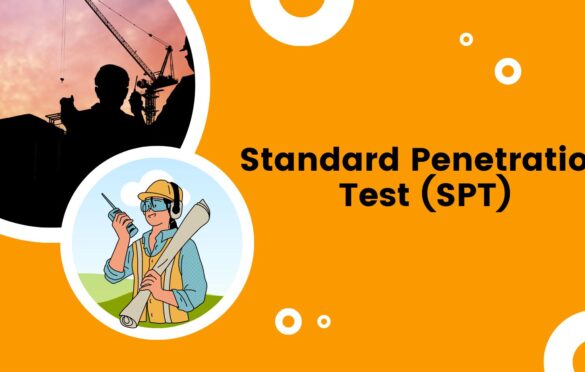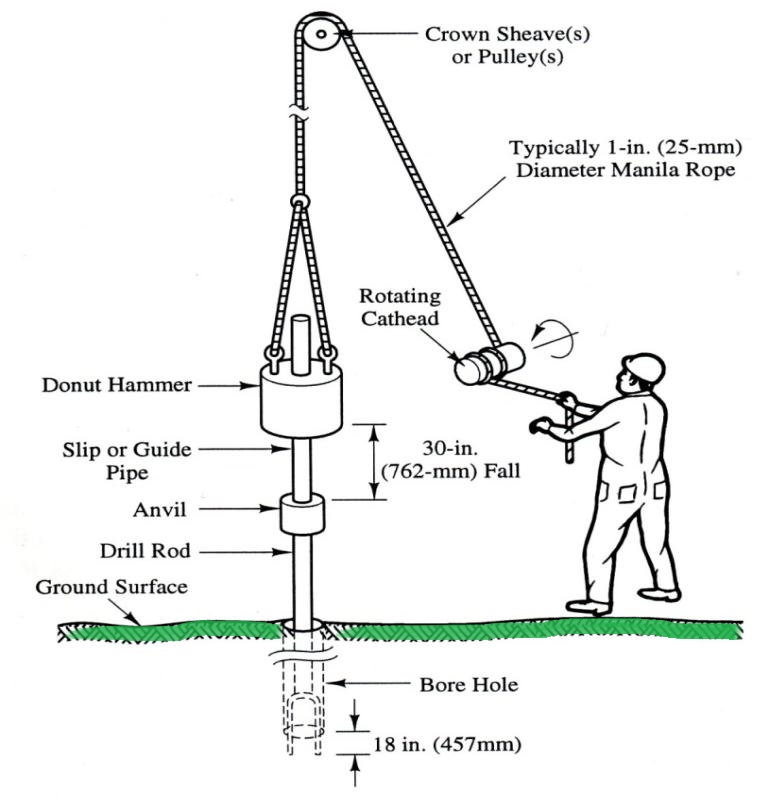Standard Penetration Test (SPT)

What is Standard Penetration Test (SPT)?
The Standard Penetration Test (SPT) is a widely used in-situ test for determining the geotechnical properties of soil. It is a simple and inexpensive test that provides a large amount of data on soil properties such as strength, density, and compressibility. The test is conducted by drilling a borehole to a desired depth, then inserting a split-spoon sampler into the borehole.
The sampler is then driven into the soil using a standard weight hammer falling from a standard height. The number of hammer strikes required to drive the sampler a set distance into the soil is recorded, and this data is used to classify the soil and to design foundations, slopes, and embankments. Additionally, the data can also be used to estimate the liquefaction potential of soils. The SPT test is a widely accepted method for soil testing and is commonly used in geotechnical engineering and construction projects.
How is Standard Penetration Test (SPT) conducted?
The Standard Penetration Test (SPT) is conducted by driving a split-spoon sampler into the soil using a standard weight hammer falling from a standard height. The standard weight of the hammer is 63.5 kg (140 lbs) and it is dropped from a height of 760 mm (30 inches). The split-spoon sampler is driven into the soil at a rate of 2.5 cm (1 inch) per blow. The number of blows required to drive the sampler a set distance into the soil is recorded. The standard depth of penetration for the sampler is 30 cm (1 ft) or sometimes more, depending on the purpose and specifics of the project. The data obtained from the test is used to classify the soil and to design foundations, slopes, and embankments, as well as for liquefaction potential assessment.

Applications of Standard Penetration Test (SPT) in geotechnical engineering
The Standard Penetration Test (SPT) is a widely used in-situ test that provides valuable information on the geotechnical properties of soil. It is commonly used in geotechnical engineering and construction projects for several purposes, including:
Soil classification: The SPT data can be used to classify soil into different types, such as sandy soils, silty soils, and clay soils. This information is important for determining the suitability of soil for different types of construction projects.
Foundation design: The SPT data can be used to estimate the bearing capacity of soil and design foundations for buildings, bridges, and other structures.
Slope stability analysis: The SPT data can be used to estimate the shear strength of soil and assess the stability of slopes and embankments.
Liquefaction assessment: The SPT data can be used to estimate the liquefaction potential of soil. Liquefaction is a phenomenon that occurs when soil loses its strength during an earthquake and behaves like a liquid. The SPT data can be used to estimate the likelihood of liquefaction occurring and to design structures to resist it.
Correlation with other tests: The SPT data can be correlated with other in-situ tests such as cone penetration test (CPT), plate load test, and others to get more accurate results for different soil parameters.
It is important to note that the SPT test is sensitive to borehole conditions, it can be affected by soil disturbance, and it does not provide direct measurements of soil properties, it is used in combination with other tests and methods to get the most accurate results.
Interpretation of results from Standard Penetration Test (SPT)
The results from the Standard Penetration Test (SPT) are typically reported as the number of blows required to advance the split-spoon sampler a set distance into the soil, known as the “N-value”. The N-value is an in-situ measure of soil strength and is commonly used in geotechnical engineering for several purposes.
Soil classification: The N-value can be used to classify soil into different types based on the blow count. For example, N-values of less than 10 indicate loose sand, N-values between 10 and 40 indicate medium dense sand, and N-values greater than 40 indicate dense sand.
Estimation of bearing capacity: The N-value can be used to estimate the bearing capacity of soil. The relationships between N-value, soil type, and bearing capacity have been established through extensive research, and are commonly used in foundation design.
Estimation of shear strength: The N-value can be used to estimate the shear strength of soil. Relationships between N-value and soil shear strength have been established, and are commonly used in slope stability analysis.
Estimation of liquefaction potential: The N-value can be used to estimate the liquefaction potential of soil. The relationships between N-value and liquefaction potential have been established through extensive research, and are commonly used in seismic design.
However, it is important to note that the N-value is only an indicator of soil strength and should not be used as the sole basis for design or construction decisions. The results of the SPT test should always be used in conjunction with other soil data and engineering judgment. Additionally, the N-value can vary significantly depending on the soil disturbance, it is important to consider this in the interpretation of the results.
Correlations of SPT results based on different authors
Skempton (1954) correlation is widely used to classify soil types based on the Standard Penetration Test (SPT) N-value. According to this correlation, soil types are classified as follows:
N ≤ 4: Very loose soil
4 < N ≤ 10: Loose soil
10 < N ≤ 40: Medium dense soil
40 < N ≤ 70: Dense soil
N > 70: Very dense soil
Terzaghi (1943) correlation relates the blow count (N-value) to the effective overburden pressure (p) and is commonly used for sandy soils. The formula is:
p = (N60)/(2D)
Where:
p = effective overburden pressure (kg/cm²)
N = blow count (SPT)
D = depth of penetration (cm)
Standard Penetration Test (SPT) N-value is the correlation proposed by Schmertmann (1978). The formula for this correlation is: ϕ = (N-20) / 2
Where:
• ϕ = angle of internal friction (degrees)
• N = blow count (SPT)
Standard Penetration Test (SPT) Calculator
Angle of internal friction (ϕ):
It’s important to note that these are only some examples of commonly used correlations, and there are many other correlations that have been proposed by different authors. Additionally, it’s important to keep in mind that these correlations are based on research and have been proposed by different authors.
Therefore, it is important to consider the soil conditions, the author’s method, and the applicability of the correlation when interpreting the results. Furthermore, it is important to consult with geotechnical engineer to use the appropriate correlation and take into account the actual site conditions and the uncertainty of the results.

